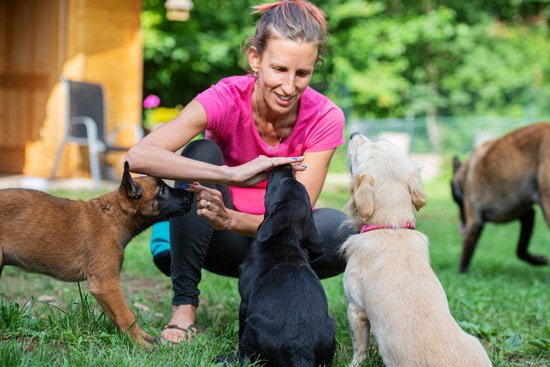One of the most common debates in the dog training world is whether to use treats or not. On one side, you have those who swear by treats and use them as a powerful motivator to get their dogs to learn new behaviors. On the other side, you have those who believe that treats should only be used as a reward after the dog has already learned the behavior and should not be used as a bribe. So which side is right?
The answer is, as with most things in life, it depends. It depends on the dog, it depends on the behavior, and it depends on the trainer. Some dogs are very motivated by treats and can be easily trained using them. Other dogs are not as motivated by treats and need other forms of motivation, such as praise or toys. And still other dogs may be motivated by both treats and other forms of motivation.
It also depends on the behavior. Some behaviors, such as sitting or lying down, are easy for dogs to learn and can be taught with just a few treats. Other behaviors, such as coming when called or walking on a loose leash, are more difficult and may take longer to train. In these cases, it is often necessary to use treats as a bribe to get the dog to perform the behavior. Once the dog has learned the behavior, however, the treats can be phased out and replaced with other forms of reinforcement, such as praise or a pat on the head.
And finally, it depends on the trainer. Some trainers are able to get their dogs to learn behaviors without using any treats at all. Other trainers find that treats are essential in getting their dogs to learn. The best trainers are those who are able to adapt to their dog’s individual needs and use the most appropriate form of motivation for that dog.
So should you use treats to train your dog? The answer is, it depends. If your dog is motivated by treats and you are able to use them effectively, then treats can be a very powerful training tool. However, if your dog is not motivated by treats or you are having difficulty training a certain behavior, then you may need to try a different approach.
Dog Training Treat Pouch Diy
Providing positive reinforcement is an important part of dog training, and a treat pouch can be a great way to carry treats with you while you train. You can make your own treat pouch out of a simple cloth bag, or you can buy a premade pouch. If you’re making your own, choose a sturdy fabric that will hold up to wear and tear. You’ll also need a piece of elastic or a strip of Velcro to keep the pouch closed.
To make a treat pouch, start by cutting a piece of fabric that is about 18 inches wide by 12 inches high. Fold the fabric in half so that the 12-inch side is now 6 inches wide, and sew along the edge. Turn the fabric right side out, and sew a piece of elastic or Velcro along the top edge. Now your pouch is ready to use!
When you’re training your dog, always have a few treats handy in your pouch. Start by rewarding your dog for good behavior with a treat, and then continue to give them treats intermittently throughout the training session. This will help your dog stay motivated and keep up the good work.
Waggin Train Chicken Jerky Dog Treats 36 Oz
The Waggin Train chicken jerky dog treats are made out of real chicken breast meat that has been sliced into thin strips. The treats are oven-baked and have a chewy texture that most dogs seem to love.
The Waggin Train chicken jerky dog treats come in a 36 oz. bag and are a good value for the price. They are also a good source of protein for dogs and can help to keep them healthy and fit.
The only downside to these treats is that they may be a little too chewy for some dogs, and they can also be a bit messy.
Dog Training Treat Belt
If you’re looking for a way to keep your treats handy while you’re training your dog, a treat belt might be just what you need. Treat belts come in a variety of styles, but they all have one thing in common – they hold treats close to your dog so you can reward them quickly and easily.
Most treat belts have several pockets or pouches that can hold a variety of treats, from small training treats to larger pieces of food. Some belts even have built-in water bottles or other accessories, like whistles, that can come in handy while you’re training your dog.
If you’re looking for a way to keep your treats handy while you’re training your dog, a treat belt might be the perfect solution. Most belts have several pockets or pouches that can hold a variety of treats, from small training treats to larger pieces of food. Some belts even have built-in water bottles or other accessories, like whistles, that can come in handy while you’re training your dog.
When choosing a treat belt, be sure to pick one that’s comfortable to wear. The belt should fit snugly around your waist, and the pockets should be easy to reach. If you’re going to be using the belt for long training sessions, be sure to choose a belt that’s comfortable and won’t chafe your skin.
A treat belt is a great way to keep your treats close at hand while you’re training your dog. Most belts have several pockets or pouches that can hold a variety of treats, from small training treats to larger pieces of food. Some belts even have built-in water bottles or other accessories, like whistles, that can come in handy while you’re training your dog.
When choosing a treat belt, be sure to pick one that’s comfortable to wear. The belt should fit snugly around your waist, and the pockets should be easy to reach. If you’re going to be using the belt for long training sessions, be sure to choose a belt that’s comfortable and won’t chafe your skin.
Best Dog Treats For Training Puppies
There are many different types of best dog treats for training puppies. The most important part of choosing the right treats for your pup is to make sure that they are healthy and nutritious. Puppies need plenty of protein and other nutrients in order to grow and develop properly.
Some good choices for healthy treats include:
-Lean, cooked meat such as chicken, turkey, or beef
-Fish such as salmon or sardines
-Fresh fruits and vegetables such as blueberries, carrots, or green beans
-Unsalted, whole grain crackers or cereal
-Baked, unsalted, low-fat dog biscuits
When choosing treats for training, it is important to avoid those that are high in sugar or fat. These treats can be unhealthy for puppies and may lead to weight gain or other health problems.
It is also important to keep in mind that treats should not make up more than 10% of a puppy’s daily caloric intake. Too many treats can lead to obesity and other health problems.
When choosing the best dog treats for training puppies, it is important to consider the individual pup’s needs and preferences. Some puppies may prefer softer treats, while others may prefer crunchy ones. It is also important to keep in mind the size of the treats. Larger treats may be difficult for smaller puppies to chew.
The best dog treats for training puppies are healthy, nutritious, and compatible with the pup’s individual preferences.

Welcome to the blog! I am a professional dog trainer and have been working with dogs for many years. In this blog, I will be discussing various topics related to dog training, including tips, tricks, and advice. I hope you find this information helpful and informative. Thanks for reading!





